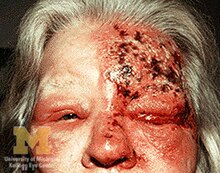Herpes zoster ophthalmicus
| Herpes zoster ophthalmicus | |
|---|---|
| Other names | Ophthalmic zoster |
acyclovir, steroid eye drops | |
| Frequency | Up to 125,000 per year (US)[1] |
Herpes zoster ophthalmicus (HZO), also known as ophthalmic zoster, is shingles involving the eye or the surrounding area. Common signs include a rash of the forehead with swelling of the eyelid. There may also be eye pain and redness, inflammation of the conjunctiva, cornea or uvea, and sensitivity to light. Fever and tingling of the skin and allodynia near the eye may precede the rash. Complications may include visual impairment, increased pressure within the eye, chronic pain,[1][2][3] and stroke.[4]
The underlying mechanism involves a reactivation of the latent varicella zoster virus (VZV) within the trigeminal ganglion supplying the ophthalmic nerve (the first division of the trigeminal nerve). Diagnosis is generally based on signs and symptoms.[2] Alternatively, fluid collected from the rash may be analyzed for VZV DNA using real-time PCR. This test is rapid, easy to perform, and is highly sensitive and specific method for diagnosing this condition.[5]
Treatment is generally with
Signs and symptoms
Skin

- Viral prodrome
- Preherpetic neuralgia
- Rash, transitioning from pustules to scabs.
- cutaneous involvement of the tip of the nose, indicating nasociliary nerve involvement. While a positive Hutchinson's sign increases the likelihood of ocular complications associated with HZO, it's absence does not rule out ophthalmic involvement.[6]
- Disseminated distribution in individuals with immunodeficiency.[7]
Cornea

- Epithelial: punctate epithelial erosions and pseudodendrites: often have anterior stromal infiltrates. Onset 2 to 3 days after the onset of the rash, resolving within 2–3 weeks. Common.
- Stromal:
- Nummular keratitis: have anterior stromal granular deposits. Occurs within 10 days of onset of rash. Uncommon
- Necrotising interstitial keratitis: Characterised by stromal infiltrates, corneal thinning and possibly perforation. Occurs between 3 months and several years after the onset of rash. Rare.
- anterior chamber and fine keratic precipitates. Chronic. Occurs between 3 months and several years after the onset of the rash. Uncommon.
- Neurotrophic: corneal nerve damage causes a persistent epithelial defect, thinning and even perforation. The cornea becomes susceptible to bacterial and fungal keratitis. Chronic. Late onset. Uncommon.
- Mucous plaques: linear grey elevations loosely adherent to the underlying diseased epithelium/stroma. Chronic. Onset between 3 months and several years after the onset of the rash.[7]
Uveal
Features:[8]
This non-
- Small keratic precipitates
- Mild aqueous flare
- Occasionally haemorrhagic hypopyon
HZO uveitis is associated with complications such as iris atrophy and secondary glaucoma are not uncommon. Complicated cataract may develop in the late stages of the disease.
Anatomy
HZO is due to reactivation of VZV within the trigeminal ganglion. The trigeminal ganglion give rise to the three divisions of cranial nerve V (CN V), namely the ophthalmic nerve, the maxillary nerve, and the mandibular nerve. VZV reactivation in trigeminal ganglion predominantly affects the ophthalmic nerve, for reasons not clearly known. The ophthalmic nerve gives rise to three branches: the supraorbital nerve, the supratrochlear nerve, and the nasociliary nerve. Any combination of these nerves can be affected in HZO, although the most feared complications occur with nasociliary nerve involvement, due to its innervation of the eye.[citation needed] The supraorbital and supratrochlear nerves mainly innervate the skin of the forehead.[citation needed] The frontal nerve is more commonly affected than the nasociliary nerve or lacrimal nerve.[8]
Treatment
Treatment is usually with antivirals such as
References
- ^ a b c d "Herpetic Corneal Infections: Herpes Zoster Ophthalmicus". www.aao.org. Archived from the original on 15 August 2020. Retrieved 21 December 2019.
- ^ a b c d "Herpes Zoster Ophthalmicus - Eye Disorders". Merck Manuals Professional Edition. Archived from the original on 12 August 2016. Retrieved 21 December 2019.
- ^ PMID 12449270.
- PMID 25712420.
- S2CID 24215093.
- from the original on 2023-07-08. Retrieved 2022-09-06.
- ^ ISBN 9780199552641. Archivedfrom the original on 2023-07-08. Retrieved 2020-11-11.
- ^ ISBN 9781905740789. Archivedfrom the original on 2023-07-08. Retrieved 2020-11-11.
- PMID 27841441.
